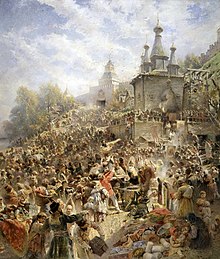Smuta
When the time of troubles or Time of Troubles (russ. Смутное время, Smutnoje Vremya ) is in the history of Russia , the time between the end of the Rurik dynasty with the death of Feodor I in 1598 and the beginning of the Romanov dynasty with the accession to power Michael I. designated in 1613. At that time there were five regents on the throne of the tsar .
course

During the reign of Fjodor I , Boris Godunov ruled the country as the actual ruler. During his later reign he tried to lead Russia out of backwardness, but encountered bitter resistance from the boyars and the church . In addition, there were three famines between 1601 and 1604, which shook the country's economy and social structures.
The situation was made worse by the intervention of Sweden and Poland . Polish troops succeeded in conquering Moscow in 1605, and the Polish King Sigismund III. put the so-called fake Dimitri on the tsar's throne, a Russian impostor . He pretended to be Tsarevich Dmitri , the son of Ivan IV, who had died under mysterious circumstances . Initially, the false Dimitri had the support of the population, who longed for orderly conditions. The nobility , however, was in opposition to him. When he tried to reform the country along the lines of the Polish model, he also lost the support of the peasants and was only supported by the occupying power. The more this was hated by their attacks, the more untenable the situation became for the false Dmitri. He was murdered and popular uprisings broke out throughout the empire.
The situation became even more unstable: The new tsar Vasily Shuiski , who relied on boyars and Swedes, was hated by the peasants and was never able to establish his rule throughout the country, especially since he was harassed by a second false Dimitri . He was able to defeat this with Swedish help in 1610 , but was overthrown shortly afterwards with Polish help. The Poles, who started fighting at the end of 1609 , occupied Moscow in the course of the Polish advance. Shortly afterwards, the Polish Crown Prince Władysław was installed as tsar against guarantees (which could have been the beginning of a “constitutional” development). Polish rule, characterized by violence and robbery in Russian cities as well as contradictions between Catholicism and Orthodoxy , increasingly lost support in society. There were a number of cities in the northwest and east that refused to take the oath from Władysław. When his own father, King Sigismund III. even claimed the throne of the tsar and rejected any restrictions on rule, this meant Władysław's final disavowal. The result was an almost three-year period of complete sovereignty.
In 1612 a popular uprising broke out in Moscow under the leadership of the Nizhny Novgorod merchant Kusma Minin and Prince Dmitri Poscharski with the support of Metropolitan Filaret , which ended the Polish occupation. The Minin and Poscharsky monument on Red Square in front of St. Basil's Cathedral in Moscow commemorates the two leaders of the uprising .
In the following year Michael I was elected as the new tsar by an imperial assembly, the Semski Sobor . This managed to stabilize the country halfway and to establish the tsar dynasty of the Romanovs .
reception
A dramatization of the first phase of this period is the opera Boris Godunow by Modest Mussorgsky , which is based on a drama of the same name by Alexander Pushkin .
literature
swell
- The German officer and adventurer Conrad Bussow describes the years between 1584 and 1613 in his Muscovite Chronicle. The text is available in various editions, for example The disturbed state of the Russian realm , translated and edited by G. Edward Orchard, Montreal [u. a.] 1994, ISBN 0-7735-1165-2 , or Zeit der Verren : Muscovite Chronicle of the years 1584 to 1613 , translated from Early New High German by Marie-Elisabeth Fritze, ed. and commented by Jutta Harney and Gottfried Sturm, Berlin [u. a.] 1991, ISBN 3-7338-0064-8 .
Representations
- Chester SL Dunning: A short history of Russia's first civil war. The Time of Troubles and the founding of the Romanov dynasty. Pennsylvania State University Press, University Park Pa 2004, ISBN 0-271-02465-8 .
Individual evidence
- ↑ Against the background of high export taxes and strong population growth, several weather- related crop failures that occurred after the outbreak of Huaynaputina triggered the famine: Chester Dunning: The Preconditions of Modern Russia's first Civil War . In: Russian History . 1 and 2, 1998, doi : 10.1163 / 187633198X00095 . KL Verosub and J. Lippman: Global Impacts of the 1600 Eruption of Peru's Huaynaputina Volcano . In: Eos . tape 89 , no. 15 , 8 April 2008, doi : 10.1029 / 2008EO150001 . Communication on this: Recent research into the influence of the Huaynaputina on the climate
- ↑ Сергей Михайлович Соловьёв : Сергей Михайлович Соловьёв: История России с древнейших времён. т. 8: От царствования Бориса Годунова до окончания междуцарствия. АСТ, Москва 2001, ISBN 5-17-002141-0 , с.791, c.825.